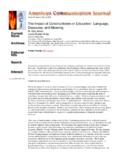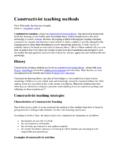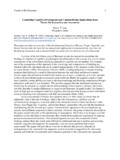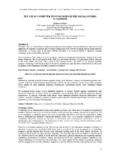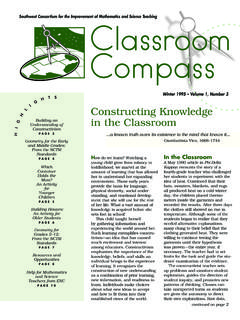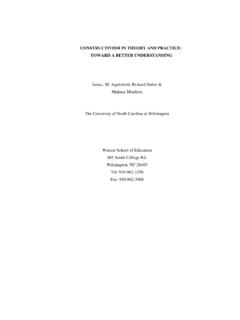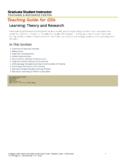Transcription of Social Constructivism - Teaching and Technology
1 Social Constructivism From Emerging Perspectives on Learning, Teaching and Technology Beaumie Kim The University of Georgia Review of Social Constructivism Contents 1 Social Constructivism Vignette 2 What is Social Constructivism ? 3 Assumptions of Social Constructivism 4 Intersubjectivity of Social Meanings 5 Social Context for Learning 6 General Perspectives of Social Constructivism on Learning 7 Social Constructivism and Instructional Models 8 Sorting Out Variations on the Terms "Constructionism" and Constructivism ". 9 References 10 Bibliography 11 Additional Resources 12 Citation Click Here to Play Lecture ( ) to play a narrated PowerPoint presentation that summarizes the content in this page. If you would like to see a transcript of the audio, click here to download script as a word document. ( ) This summary was created by Buffalo Shuford, Sheri Howard and Daniele Facundo (2006). Social Constructivism Vignette Vignette By Roy Jackson, Jessica Karp, Ellen Patrick, Amanda Thrower (2006).
2 Mrs. Smith is a high school English teacher who has struggled for years when it came to Teaching Shakespeare to her students. In the past, students became bored immediately with reading any of the plays aloud in class and consistently complained that the language was too difficult to understand. Desperate for any degree of engagement, Mrs. Smith decided to take a Social constructivist approach to Shakespeare's Hamlet with her students. Instead of reading the play aloud in class, allowing the students to remain passive and uninvolved with the text, Mrs. Smith divided the class into five cooperative groups and assigned each group one act of the play. She then explained that each group was to turn their assigned act into a modern-day puppet show. The groups were to read, interpret, and translate their act into modern language (they were even encouraged to use common slang when appropriate.) They were also required to create puppets to represent the characters and ultimately perform their act for the rest of the class.
3 Each group worked together with Mrs. Smith's guidance to create a shared understanding of their assigned act and use that shared understanding as a basis for their construction of the modern-day puppet show. In the end, they produced a product that was created through a Social learning process. The class was divided into groups of four. Because each group was comprised of various learners with diverse interests and backgrounds, each member had something unique to offer in their group's construction of the puppet show. One particular group was assigned Act I of Hamlet. They included Henry, who moved from Louisiana last year after Hurricane Katrina, Suzanne who loves hip-hop music, Nia, who loves to write, and Juan who enjoys comic books and likes to draw. All four were excited about different aspects of the project but would have been very uncomfortable trying to understand their assigned act of the play and turn it in to a modern puppet show on their own.
4 At the first meeting, the group decided it was best to start by reading and discussing Act I together; Nia offered her writing skills to the task of making notes about the progression of the plot and the characters' actions as the group interacted and constructed meaning out of what they read. Once they felt as though they had a firm understanding of Act I, they shared their findings and notes with Mrs. Smith who, in turn, provided feedback. At the next meeting, they moved on to the more creative aspects of the project, where everyone was able to contribute their own personal skills and talents. The group decided to present their act in a Cajun dialect. Growing up in New Orleans, Henry was very familiar with the Cajun dialect and culture, so he and Nia joined forces in writing a script for the puppet show. For background music, they decided hip-hop would fit well with the Cajun influence; Suzanne agreed to work on finding hip-hop selections that would work well with the story.
5 Juan gladly volunteered to take on the creation of the puppets. He wanted to use what he had learned about the characters through the group's previous interactions and create modern interpretations with a comic book influence. By the time the product was constructed, each group member's mark was on the final outcome, so each had a sense of ownership. The intersubjectivity the students experienced through this group project allowed them to extend their understanding of Shakespeare's Hamlet. In addition to completing the part each agreed to do, the students had to communicate, share and negotiate to create the final product. The students brought their diverse interests and collaborated to create their finished product. Mrs. Smith's use of the Social constructivist approach to this lesson proved successful as the students came to a clear and engaged understanding of Hamlet, her ultimate goal. What is Social Constructivism ?
6 Social Constructivism emphasizes the importance of culture and context in understanding what occurs in society and constructing knowledge based on this understanding (Derry, 1999; McMahon, 1997). This perspective is closely associated with many contemporary theories, most notably the developmental theories of Vygotsky and Bruner, and Bandura's Social cognitive theory (Shunk, 2000). Assumptions of Social Constructivism Social Constructivism is based on specific assumptions about reality, knowledge, and learning. To understand and apply models of instruction that are rooted in the perspectives of Social constructivists, it is important to know the premises that underlie them. Reality: Social constructivists believe that reality is constructed through human activity. Members of a society together invent the properties of the world (Kukla, 2000). For the Social constructivist, reality cannot be discovered: it does not exist prior to its Social invention.
7 Knowledge: To Social constructivists, knowledge is also a human product, and is socially and culturally constructed (Ernest, 1999; Gredler, 1997; Prat & Floden, 1994). Individuals create meaning through their interactions with each other and with the environment they live in. Learning: Social constructivists view learning as a Social process. It does not take place only within an individual, nor is it a passive development of behaviors that are shaped by external forces (McMahon, 1997). Meaningful learning occurs when individuals are engaged in Social activities. Intersubjectivity of Social Meanings Intersubjectivity is a shared understanding among individuals whose interaction is based on common interests and assumptions that form the ground for their communication (Rogoff, 1990). Communications and interactions entail socially agreed-upon ideas of the world and the Social patterns and rules of language use (Ernest, 1999).
8 Construction of Social meanings, therefore, involves intersubjectivity among individuals. Social meanings and knowledge are shaped and evolve through negotiation within the communicating groups (Gredler, 1997; Prawat & Floden, 1994). Any personal meanings shaped through these experiences are affected by the intersubjectivity of the community to which the people belong. Intersubjectivity not only provides the grounds for communication but also supports people to extend their understanding of new information and activities among the group members (Rogoff, 1990; Vygotsky, 1987). Knowledge is derived from interactions between people and their environments and resides within cultures (Shunk, 2000; McMahon, 1997). The construction of knowledge is also influenced by the intersubjectivity formed by cultural and historical factors of the community (Gredler, 1997; Prawat & Floden, 1994). When the members of the community are aware of their intersubjective meanings, it is easier for them to understand new information and activities that arise in the community.
9 Caption: Two people, interacting through communication, help to extend each other's understanding of what makes a rainbow. The flash graphic above illustrating the intersubjectivity of Social meanings was created by Nina Augustin and Wan-Ting Huang (2002). Social Context for Learning Some Social constructivists discuss two aspects of Social context that largely affect the nature and extent of the learning (Gredler, 1997; Wertch, 1991): Historical developments inherited by the learner as a member of a particular culture. Symbol systems, such as language, logic, and mathematical systems, are learned throughout the learner's life. These symbol systems dictate how and what is learned. The nature of the learner's Social interaction with knowledgeable members of the society is important. Without the Social interaction with more knowledgeable others, it is impossible to acquire Social meaning of important symbol systems and learn how to use them.
10 Young children develop their thinking abilities by interacting with adults. General Perspectives of Social Constructivism on Learning Social constructivists see as crucial both the context in which learning occurs and the Social contexts that learners bring to their learning environment. There are four general perspectives that inform how we could facilitate the learning within a framework of Social Constructivism (Gredler, 1997): Cognitive tools perspective: Cognitive tools perspective focuses on the learning of cognitive skills and strategies. Students engage in those Social learning activities that involve hands-on project-based methods and utilization of discipline-based cognitive tools (Gredler, 1997; Prawat & Folden, 1994). Together they produce a product and, as a group, impose meaning on it through the Social learning process. Idea-based Social Constructivism : Idea-based Social Constructivism sets education's priority on important concepts in the various disciplines ( part-whole relations in mathematics, photosynthesis in science, and point of view in literature, Gredler, 1997, ; Prawat, 1995; Prawat & Folden, 1994).




